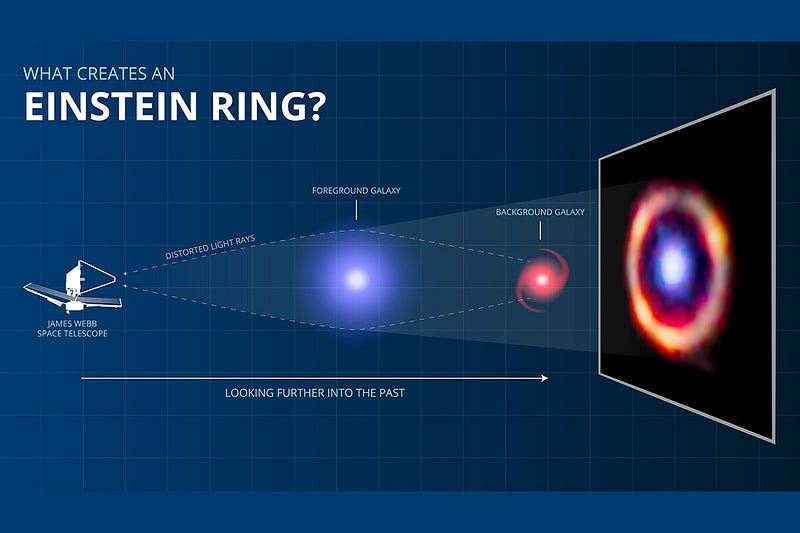Unveiling Ancient Organic Molecules: A Webb Telescope Breakthrough
Written on
Chapter 1: The Webb Telescope's Revolutionary Findings
In a remarkable false-color image captured by the Webb Telescope, the foreground galaxy appears in blue while the background galaxy is depicted in red. The organic molecules are emphasized in orange, showcasing a significant scientific breakthrough.

The James Webb Space Telescope (JWST) continues to expand its impressive repertoire of discoveries within just a year of its operation. One of its latest findings is particularly astonishing: researchers have uncovered evidence of the oldest and farthest organic molecules, located over 12 billion light-years from Earth. This groundbreaking discovery was made possible through gravitational lensing, a technique that allows astronomers to observe distant objects by bending light around massive celestial bodies.
Gravitational lensing acts as a natural magnifying glass, enabling scientists to study phenomena that would otherwise be too faint or far away. This technique not only provides insights into the mass distribution of galaxies but also sheds light on the nature of dark matter, the universe's expansion rate, and the formation of large-scale structures.
An international research team, including astronomers from the University of Illinois Urbana-Champaign and Texas A&M University, has made a pioneering discovery by identifying complex organic molecules in a distant galaxy. This marks the farthest known galaxy in which such molecules have been found. Utilizing advanced methods, the team successfully distinguished between infrared signals produced by the galaxy's massive dust grains and newly detected hydrocarbon molecules.

“What this research is telling us right now — and we are still learning — is that we can see all of the regions where these smaller dust grains are located — regions that we could never see before the JWST.”
~ Kedar Phadke, Researcher

According to this innovative research, the identified complex molecules are known as polycyclic aromatic hydrocarbons (PAHs). While PAHs are commonly found on Earth in sources such as wildfire smoke and vehicle emissions, their presence in the cosmos could significantly impact star formation. Researchers theorize that PAHs might help regulate the temperature of gas clouds within stellar nurseries, ultimately affecting when and where stars form.

The research team focused on a distant object named SPT0418–47. Initially discovered using the National Science Foundation's South Pole Telescope, this dust-obscured galaxy was magnified by gravitational lensing, allowing it to be observed with a factor of approximately 30 to 35. Situated 12 billion light-years from Earth, this galaxy existed when the universe was less than 1.5 billion years old, representing merely 10% of its current age.
Upon examining the light emitted from SPT0418–47, the team identified a wealth of heavy elements that the South Pole Telescope could not detect. The JWST, however, possesses the precise infrared capabilities to identify polycyclic aromatic hydrocarbons (PAHs). When the team directed the telescope toward the galaxy in August of the previous year, a multitude of complex organic molecules became distinctly visible.
The first video titled "Breaking the Code: Webb Telescope Shocks Scientists with Unprecedented Organic Molecule Find" provides an overview of this remarkable discovery, highlighting the implications of these ancient organic molecules.
Discovery of water on a comet is Webb’s latest & astounding revelation
JWST’s detection of water vapor on Comet Read could provide the key to the broader investigation into the origin of…
This discovery bolsters the idea that organic molecules are integral to the star formation process. Interestingly, the research team also noted regions within the galaxy devoid of PAH clouds, yet stars were still forming in those areas. As researchers suggest, this phenomenon warrants further investigation to understand the underlying mechanisms of star formation in these regions.
The second video titled "James Webb Telescope BIZARRE Discovery Pushes our Universe Back by a Billion Years" delves into the implications of these findings for our understanding of cosmic history.
The complete research has been published in the Journal of Nature.